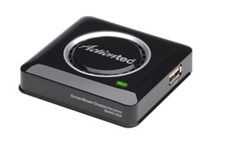 We’ve tested a number of Windows tablets here at UMPCPortal and one of the biggest issues we hear is on video output. People like their HDMI ports and when it’s not available on their ‘PC’ they’re not happy. There are questions to be asked about how often you’d really use it on a device that’s targeted at consumption, yes, but these Windows tablets do more than just help users consume content and that’s the point. Luckily there are options for those that don’t have the port. They come with limitations, yes, but they can also have advantages. Take the wireless video solution WiDi for example. In this article I take a deep-dive into this wireless display technology that you’ll find on many new Intel-based Tablets, 2-in-1s and Ultrabooks.
We’ve tested a number of Windows tablets here at UMPCPortal and one of the biggest issues we hear is on video output. People like their HDMI ports and when it’s not available on their ‘PC’ they’re not happy. There are questions to be asked about how often you’d really use it on a device that’s targeted at consumption, yes, but these Windows tablets do more than just help users consume content and that’s the point. Luckily there are options for those that don’t have the port. They come with limitations, yes, but they can also have advantages. Take the wireless video solution WiDi for example. In this article I take a deep-dive into this wireless display technology that you’ll find on many new Intel-based Tablets, 2-in-1s and Ultrabooks.
Intel sent me an Actiontec ScreenBeam to test recently and the more I use it the more I wish it was permanently connected to the TV in my living room. No, I don’t want to work from the sofa, I want to present and presenting content wirelessly is so much easier than having to connect a cable that tethers you to the screen.
I’ve got a couple of video demos below but first, lets look at what WiDi really is, go over the specifications and alternatives, issues and link you to some further reading.
Wireless Display is an Intel technology built into many Ultrabooks and Intel-powered tablets. It uses a combination of software and hardware to compress and send FullHD video (into H.264 format) and digital audio (up to 6 channels) over a Wi-Fi connection to a WiDi receiver. It uses Wi-Fi Direct so you don’t need to be connected to the potential bottleneck of a Wi-Fi hotspot. V4.2 is the current version of WiDi although some 4.3 information and drivers are now available. A display requires either built-in WiDi or Miracast support or you can buy adaptors from about $50.
I’ve been testing with the ScreenBeam Pro that supports WiDi 4.1 and is also compatible with Miracast, which is available in Android 4.2 and later and does not require an Intel CPU.
WiDi 4.2 specifications
- Full HD video support. (60FPS max)
- Low Power Self Refresh support
- Hardware Encoding of Video (into H.264)
- HDCP 2.x output protection support
- WiUSB channel (seen supported on some Ultrabooks)
- Audio source: up to 6-channel 16-bit/48 kHz LPCM multi-channel audio
- Low latency mode (less than 150ms. Our information is that it may not support 60fps in this mode.)
- HDMI CEC “One Touch Play” support
- Support for S3D up to Full HD Res
- Quality vs Speed option on User Interface
- 5Ghz WiFi support (with compatible receiver)
- Software support required: Intel WiDi requires the Microsoft* .Net 4.0 Framework to be installed and configured on the supported
Windows operating systems.
Specific hardware may be required to support some features. In general, a 3rd or 4th-Gen Intel CPU with Intel Wireless module is a base requirement for a WIndows 7 or Windows 8 system. More information here.
Intel recently announced WiDi for business use which includes additional security and collaboration features. More information on Intel Pro Wireless Display in the Intel PDF here.
 Miracast is a similar technology that can be viewed as a sub-set of WiDi features. As with WiDi it supports protected content. It is supported natively in Android 4.2 (although only Android 4.4 and later devices can be Miracast certified) with compatible hardware. The Nvidia Tegra 3 platform supports Miracast, for example. Miracast is supported natively in Windows 8.1. The WiDi software also includes Miracast support.
Miracast is a similar technology that can be viewed as a sub-set of WiDi features. As with WiDi it supports protected content. It is supported natively in Android 4.2 (although only Android 4.4 and later devices can be Miracast certified) with compatible hardware. The Nvidia Tegra 3 platform supports Miracast, for example. Miracast is supported natively in Windows 8.1. The WiDi software also includes Miracast support.
Apple uses its own proprietary system known as AirPlay.
QVOD in China are now producing a mini WiDi receiver that can plug directly into an HDMI port. (Image of QVOD A310W right.)
An emerging option is WiGig. Although this is targeted as a ‘transparent’ channel (near-zero perceptible latency) it is an expensive technology that doesn’t just support video and may not be suitable for consumers for many years.
Potential issues with WiDi
Screens don’t generally come with WiDi and adaptors cost $50 or more.
CPU load can be an issue on lower-power devices as it causes higher battery drain. Although video encoding hardware is used, the CPU still has work to do. On Ultrabooks the CPU load is negligible.
Latency is not low enough for most gaming or desktop-style mouse control.
Dropout is possible in areas of high Wi-Fi usage.
A large range of hardware, software and driver dependencies means many potential incompatibilities.
Some users may be able to detect H.264 compression artifacts. (I can’t!)
WiDi demo videos
In one of the videos below you’ll see a latency test showing 165ms delay.
Summary
WiDi becomes more useful the easier and cheaper it gets. Miracast support in Windows 8.1 is a good step forward but there are still issues of latency and adaptor cost to consider. As a presentation method it’s well-suited for the home and office. Prices of receivers need to come down a lot and at $30 could become very compelling. Bundle offers with tablets and Ultrabooks could help improve take-up and awareness. Promotion of WiDi as a wireless USB channel (e.g. wireless webcams, home automation, wireless backup) could help further.
More WiDi articles can be found over at our sister site Ultrabooknews here.
More WiDi information and software from Intel
White Paper: WiDi for Enterprise. (PDF)
Information: WiDi, Intel Pro and Collaboration. (PDF)











I have a nexus 5 with widi support (the menu Entry is called “Bildschirmübertragung”).
I looked for widi Adapters, but German retailers don’t offer many products to choose from. And they are quite expensive (65€-130€).
Price is a major issue. Adapters should be $30 not $70.
I am tired of the limitations and unreliable performance of both Google TV devices in my house (Sony and Logitech): None of them play You Tube via Chrome without the dreadful ‘Aw snap’ crashes. They often cannot find a dedicated home DLNA server (Zyxel) or cannot play several video formats (upon which I am stuck–can’t find easy solutions) or cannot find recently indexed DLNA videos. I don’t like my XBOX 360’s controller to play videos either. I imagine similar issues trying to play through AppleTV–plus I will have to get an Apple device.
The ONLY reliable solution I have is to use an HDMI adapter and then connect an HDMI cable from my Acer W510 to the TVs. Inconvenient, yes, but I am never stuck with these kinds of problems. A Windows 8.1 device should be the king of all living rooms! But Microsoft and its partners are too dumb to come with a WiDi or similar wireless solution.
I will keep waiting…
It’d be nice if the remote display protocol works over Ethernet and maybe even over the Internet. In my house, even 802.11ac is a bottleneck. Adding WiDi as an interfering signal will just make it worse.
I know MiracleCast on Linux implements the Miracast protocal over multiple mediums but it’s still in beta.
Watch numerous News TV films and Tv shows online. Eugot provides all of your favorite genres uncut, unedited, and unbelievably free of charge — Just press play!”